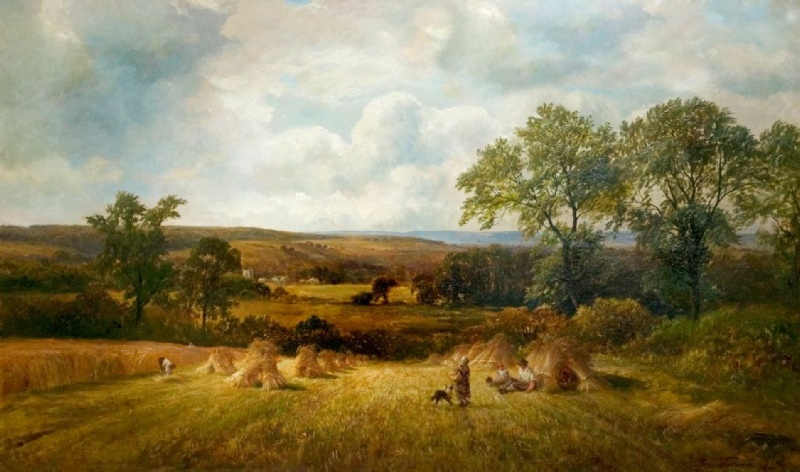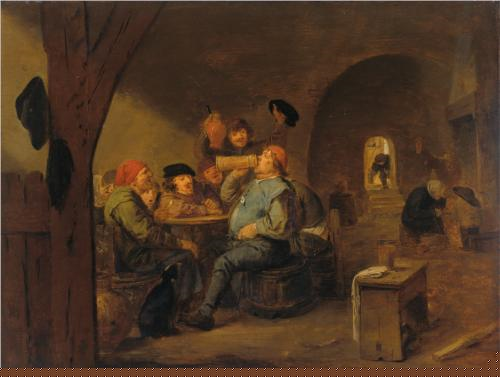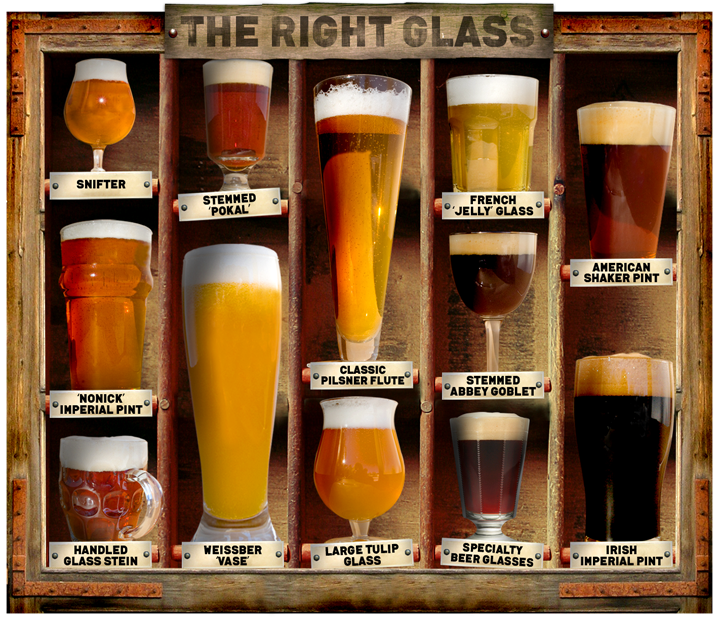A popular drinking song from rural England, Ireland and Scotland (and the Americas) that could not miss after the “crying of the neck” or during a “Harvest supper“; this auspicious song is also a tavern game: the most common form of the game sees only one singer, while the audience lifts the glass to drink twice in the refrain responding to the auspicious verse with a joyful “Good luck!”; in the second version a soloist intones the first stanza and all the participants sing in chorus the progressive refrain, whom that mistakes the words, or takes a breath to sing, must drink. Obviously the goal of the game is to drink more and more, as you make mistakes!

GIVE US ONCE A DRINKE
The song is very ancient as the rituals inherent to the harvest of wheat / barley are ancient (see traditional methods); the first known publication dates back to 1609, in the Deuteromelia by Thomas Ravenscroft, with the title “Give Us Once A Drinke” is transcribed as it was sung in the Elizabethan taverns.
“Give us once a drink for and the black bole(1)
Sing gentle Butler(2) “balla moy”(3)
For and the black bole,
Sing gentle Butler balla moy”
and it ended with:
“Give us once a drink for and the tunne
Sing gentle Butler balla moy
The tunne, the butt The pipe, the hogshead The barrel, the kilderkin The verkin, the gallon pot The pottle pot, the quart pot, The pint pot,
for and the black bole
Sing gentle Butler balla moy”
NOTES
1) What were the beer glass like in medieval taverns? The three most common materials at the time were metal (pewter), glass and ceramics. In Italy in the fourteenth century, for example in the taverns, glass was more common. Here we quote a black bowl that makes one think more properly of a dark bowl or cup, perhaps made of wood? In the wassaling songs, which are also very old, the material of the toast cups carved in the wood is often described. Later, the use of pewter is more likely.
2) bottler
3) the scholars believe it could be for ‘Bell Ami’, only later the song became part of the songs during the Harvest festival and the verse was changed to ‘Barley Mow’, others believe that it is a Mondegreen.
BARLEY MOW
Over time, new strophes have been added and especially in the nineteenth century there are many transcriptions in the collections of old traditional songs such as in “Songs of the Peasantry of England”, by Robert Bell 1857 : This song is sung at country meetings in Devon and Cornwall, particularly on completing the carrying of the barley, when the rick, or mow of barley, is finished. On putting up the last sheaf, which is called the craw (or crow) sheaf, the man who has it cries out ‘I have it, I have it, I have it;’ another demands, ‘What have ’ee, what have ’ee, what have ’ee?’ and the answer is, ‘A craw! a craw! a craw!’ upon which there is some cheering,& c., and a supper afterwards. The effect of the Barley-mow Song cannot be given in words; it should be heard, to be appreciated properly, – particularly with the West-country dialect.”
Robert Bell transcribes the widespread version in West England and also the variant sung in Suffolk
| Here’s a health to the barley mow! Here’s a health to the man Who very well can Both harrow and plow and sow! When it is well sown See it is well mown, Both raked and gavelled clean, And a barn to lay it in. He’s a health to the man Who very well can Both thrash (1) and fan it clean! |
NOTES 1) in the Middle Ages there were two ways to separate the wheat grains from the ear: the farmer beat the sheaves with a stick or a whip or they were trampled by the draft animals. The sifting: wheat and chaff were separated first by placing them in a sieve and then throwing them in the air (it must of course be a breezy day) the chaff flew away and the grain returned to the sieve. |

The Barley Mow is one of the best-known cumulative songs from the English folk repertoire and was usually sung at harvest suppers, often as a test of sobriety. Alfred Williams, who noted a splendid set in the Wiltshire village of Inglesham some time prior to the Great War, wrote that he was “unable to fix its age, or even to suggest it, though doubtless the piece has existed for several centuries.” Robert Bell found the song being sung in Devon and Cornwall during the middle part of the 19th century, especially after “completing the carrying of the barley, when the rick, or mow, of barley is finished.” Bell’s comment that “the effect of The Barley Mow cannot be given in words; it should be heard, to be appreciated properly” is certainly true, and most singers who know the song pride themselves on being able to get through it without making a mistake.(Mike Yates)
So we toast to all the dimensions in which beer is marketed (and are indicated in all the existing measures in the past times from the barrel to the “bowl” and to the health of all those who “manipulate” the beer and of all the “merry brigade” who drinks it!
Arthur Smith in’The Barley Mow’ (1955) a typical pub in Suffolk in the fifties.See VIDEO:
Irish Rovers
Here’s good luck to the pint pot, good luck to the barley mow, (1) Jolly good luck to the pint pot, good luck to the barley mow; Oh, the pint pot, half a pint, gill, (2) half a gill, quarter gill Nipperkin (3) and a round bowl(4) Here’s good luck, (5) good luck, good luck to the barley mow. |
Here’s good luck to the half gallon, good luck to the barley mow, Jolly good luck to the half gallon, good luck to the barley mow; Oh, the half gallon, pint pot, half a pint, gill, half a gill … Here’s good luck to the gallon, Here’s good luck to the half barrel, Here’s good luck to the barrel, Here’s good luck to the daughter(6), Here’s good luck to the landlord, Here’s good luck to the landlady, Jolly good luck to the landlady, Jolly good luck to the brewer, (7) Here’s good luck to the company, good luck to the barley mow, Jolly good luck to the company, good luck to the barley mow; Oh, the company, brewer, landlady, landlord, daughter, barrel, Half barrel, gallon, half gallon, pint pot, half a pint, gill, Half a gill, quarter gill, nipperkin and a round bowl, Here’s good luck, good luck, good luck to the barley mow. |
NOTES
1) [shout GOOD LUCK and drink a sip!]
2) they are all units of measure ordered by the largest (barrel) to the smallest (round bowl).
But as for all units of measurement of the peasant tradition there are local differences in the measured quantity
“a gill is a half-pint in a northern pub, but a quarter-pint down south“.
3) “The nipperkin is a unit of measurement of volume, equal to one-half of a quarter-gill, one-eighth of a gill, or one thirty-second of an English pint.
In other estimations, one nip (an abbreviation that originated in 1796) is either one-third of a pint, or any amount less than or equal to half a pint“.[wiki] “A nip was also used by brewers to refer to a small bottle of ale (usually a strong one such as Barley Wine or Russian Stout) which was sold in 1/3 pint bottles“.
4) “The round bowl” sometimes also “hand-around bowl”, “brown bowl” or “bonny bowl” could be the typical cup with which toasted in the wassailing evidently a unit of measure that has been lost over time.
5) [shout GOOD LUCK, drinking is optional!]
6) the daughter of the tavern owner or more generally she is a waitress serving at the tables
7) there are those who add “the slavey” and “the drayer” to the list; “slavery” means a servant and “the draye” is the one who pulls (or guides) the cart that is the man of deliveries that in fact supplies the tavern with beer. The name derives from the fact that once such a cart was wheelless and was dragged like a sled.
HOW MUCH DOES A PINT?

The draft beer is marketed in the Anglo-Saxon countries starting from the pint that in England and Ireland corresponds to 20 ounces (568 ml ie roughly 50cl). The American pint instead corresponds to 16 ounces; so the standard glass for beer contains exactly a pint (as we call Italian “big beer”); the shapes vary according to the time and the fashions, but the capacity of the glass is always a pint! A law by the British parliament in 1698 stated that “ale and beer” (ie beer without hops and beer with hops) must be served in public only in “pints, full quarts (two pints) * or multiples thereof”. The rule was further reiterated in 1824 by imposing the imperial unit as a unit of measure for all beverages. * The glass that contains 2 imperial pints (1.14 liters) is the yard or a narrow and long glass just a yard. Today with the adaptation to European regulations the British government has “restricted” the pint to “schooner” (as it is called in Australia, but we are still waiting for the nickname that will be given in England to the new measure!) The glass equal to 2/3 pint (400 ml)
THE BARLEY MOW (ROUD 10722)
A variant always from Suffolk
| I Well we ploughed the land and we planted it, and we watched the barley grow. We rolled it and we harrowed it and we cleaned it with a hoe.(1) Then we waited ‘til the farmer said, “It’s time for harvest now. Get out your axes and sharpen, boys, it’s time for barley mow.” Chorus Well, here’s luck to barley mow and the land that makes it grow. We’ll drink to old John Barleycorn(2), here’s luck to barley mow. So fill up all the glasses, lads, and stand them in a row: A gill, a half a pint, a pint, a pint and a quart and here’s luck to barley mow. |
II Well we went and mowed the barley and we left it on the ground. We left it in the sun and rain ‘til it was nicely brown. Then one day off to the maltsters, then John Barleycorn did go. The day he went away, we all did say, “Here’s luck to barley mow.” III Have no fear of old John Barleycorn when he’s as green as grass. But old John Barleycorn is strong enough to sit you on your arse. But there’s nothing better ever brewed than we are drinking now, Fill them up: we’ll have another round, here’s good luck to barley mow. |
NOTES
1) weeding: cutting and shuffling of the ground for the most superficial part
2) John Barleycorn is the spirit of beer
LINK
https://anglofolksongs.wordpress.com/2015/09/14/the-barley-mow/
http://www.gutenberg.org/dirs/etext96/oleng10h.htm
http://www.wtv-zone.com/phyrst/audio/nfld/27/barley.htm http://www.chivalry.com/cantaria/lyrics/barleymow.html http://mainlynorfolk.info/tony.rose/songs/barleymow.html http://mudcat.org/thread.cfm?threadid=151726
http://mudcat.org/thread.cfm?threadid=3873 http://www.efdss.org/component/content/article/45-efdss-site/learning-resources/1540-efdss-resource-bank-chorus-barley-mow http://www.musicanet.org/robokopp/english/barlymow.htm

